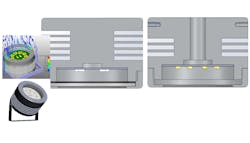Virtual prototyping of LED products across the supply chain speeds development - Part 1 (MAGAZINE)
Considerable time and money is spent on prototyping, sampling, and laboratory testing of LED-based luminaire designs, whether the application is automotive, general illumination, or a specialty product. Digitalization, that is applying Industry 4.0 principles, at higher integration levels of the solid-state lighting (SSL) supply chain would reduce these costs. To address this issue, the Delphi4LED consortium was formed, comprising 15 partners representing luminaire makers, academia, and software/testing companies with the partners coming from seven countries. The consortium goal is to develop a standardized method for creating multidomain (thermal-optical-electrical) LED-based design and simulation tools for the SSL industry, with LED models derived from test data. In Part 1 of this two-part series, we will describe how the models are to be developed, and in Part 2 coming in the next issue, we will cover pilot implementations.
Let's start with some background. The project we will discuss is called the Delphi4LED H2020 ECSEL R&D project. It was funded as part of the European Union Electronic Components and Systems for European Leadership (ECSEL) initiative. As mentioned, the consortium partners are working to develop testing and modeling methodologies for multidomain characterization of LED products with the key being that the program is focused on application at different levels of integration along the SSL supply chain. The goal is that the resulting compact models can be used as digital twins of the physical products to support virtual prototyping during the design of luminaires.
At a high level, the project seeks to align with the tenets of the Industry 4.0 movement. Industry 4.0 has been described as the fourth industrial revolution. The concept involves what have been called cyber-physical systems and ultimately manufacturing in smart factories with wireless connectivity and Industrial Internet of Things (IIoT) technology.
This article describes the new approach, the first demonstration experiment of this project done as a proof of concept, and the subsequent results.
Another key goal of the project is the scope of where the technique can be applied. The multidimensional modeling implementation should allow efficient simulation of LED applications. The modeling approach needs to be generic so it could be applied to products ranging from individual packaged LEDs up to complete luminaires through the creation of the aforementioned digital twin. The digital twin must properly represent a real, physical counterpart for simulation-based experiments and optimization.
Starting with a vision
Our first step was to create an overall vision of the different steps that need to be taken to realize fully-digitalized LED product development (Fig. 1). Two keys to this approach are the availability of compact multidomain models of packaged LEDs comprised of a boundary-condition-independent compact thermal model of the physical LED package and a multidomain, SPICE-like model that describes the LED operation at chip level. SPICE is an open-source analog electronic circuit simulator that uses standardized component models. Part of this consortium project was to develop new testing and modeling methodologies that allow easy creation of such models based on measurement data.1,2
The digital twin of the LED chip we developed is a SPICE-like multidomain LED model as introduced earlier,10,11 which was upgraded.12-14 The right set of equations and a circuit macro model along with the model parameters fitted to the measured data represents the digital twin of the LED chip. In the future, we can expect the required measurements and model parameter identification from LED vendors in a standardized format.
Testing workflow scenarios
The process of creating a thermal digital twin starts with creating calibrated detailed 3D models of the LED packages with the help of structure functions.12 These carry proprietary information from LED vendors for detailed geometry and material properties. That information is not readily available from LED product developers. LED vendors do not share such models with end users; however, end users can also build such models based on their own LED package measurements.
According to the original Delphi methodology15 and also in this new approach, from the calibrated detailed thermal models the compact thermal models are identified through an optimization process.16 In the Delphi4LED project, we create dynamic compact thermal models (DCTMs) of the LED packages.17 These are later used in luminaire-level analysis as the actual digital twins of the LED packages to represent their true thermal behavior.18
The advantage of the compact model is that it no longer carries proprietary information so LED vendors can share it without sharing their IP. A package DCTM connected to a chip-level, multidomain LED model is the ultimate digital twin of a packaged LED, provided as a SPICE netlist, for example.From the thermal point of view, a luminaire is a multi-heat-source system and the heat sources to consider are the LED packages with their footprints. A good place to start for a digital twin of an LED luminaire is its MCAD model (Fig. 3). The thermal model, as a thermal-only digital twin of the luminaire, can be extracted from this MCAD model.
A luminaire compact thermal modeling tool may use different approaches to provide the compact thermal model of the luminaire. One approach could be to identify and to convert the thermal-characterization matrix of the luminaire into a SPICE network,18 using CFD (computational fluid dynamics) simulations of a luminaire (Fig. 4). Reduced-order modeling techniques could also be used for obtaining a luminaire compact thermal model.19
The complete digital twin of an LED luminaire is obtained by combining the aforementioned luminaire compact thermal model with the digital twin of the LED package (chip-level multidomain model completed with the package DCTM). Using such a digital twin of the complete luminaire as a virtual prototype, hot lumen calculations can be performed under different environmental conditions or different design versions. Luminaire designs can be partitioned, which can be reflected by the simulation models.
In our example, the MCPCB (metal-core printed-circuit board)substrate is considered as one thermal component (described by a multi-heat-source compact model), and the luminaire body as a heat sink is considered as another component, modeled by a single, equivalent thermal resistance toward the ambient (Fig. 5).For different luminaire thermal design alternatives (Fig. 6), different thermal resistances are used as simple compact models. This way, libraries of substrates made of different materials and with different designs (copper coverage, footprint layout, etc.), and luminaires with different thermal features, can be created for later system-level design and optimization.
Both within the Delphi4LED consortium and in real life, we identified two companies that have significantly different daily design practices, based on company culture and available technical/financial resources. Based on these profiles, a pilot study and then demonstration experiments were set up by the Delphi4LED consortium.3
In Part 2 of this article, we will detail the results of pilot implementations in two different scenarios. Moreover, we will discuss how this modeling scheme can be used by small to large organizations.
REFERENCES
1. R. Bornoff et al., "Delphi4LED - From Measurements to Standardized Multi-Domain Compact Models of LEDs: a New European R&D Project for Predictive and Efficient Multi-domain Modeling and Simulation of LEDs at all Integration Levels Along the SSL Supply Chain," Proc. THERMINIC, 174-189 (Sept. 2016), DOI: 10.1109/THERMINIC.2016.7749048.
2. G. Martin et al., "Delphi4LED - from measurements to standardized multi-domain compact models of light emitting diodes (LED)," Electron. Cooling Mag., 20-23 (Aug. 2017).
3. C. Marty et al., "Design flow for the development of optimized LED luminaires using multi-domain compact model simulations," Proc. THERMINIC (Sept. 2018), DOI: 10.1109/THERMINIC.2018.8593318.
4. JEDEC JESD51-14 Standard, "Transient Dual Interface Test Method for the Measurement of the Thermal Resistance Junction-To-Case of Semiconductor Devices with Heat Flow through a Single Path" (2010).
5. JEDEC JESD51-51 Standard, "Implementation of the Electrical Test Method for the Measurement of Real Thermal Resistance and Impedance of Light-Emitting Diodes with Exposed Cooling" (2012).
6. JEDEC JESD51-52 Standard, "Guidelines for Combining CIE 127:2007 Total Flux Measurements with Thermal Measurements of LEDs with Exposed Cooling Surface" (2012).
7. CIE 225:2017 Technical Report, "Optical Measurement of High-Power LEDs," ISBN 978-3-902842-12-1, DOI: 10.25039/TR.225.2017 (2017).
8. G. Farkas, A. Poppe, "Thermal testing of LEDs," Thermal Management for LED Applications, 73-165, Springer (2014), DOI: 10.1007/978-1-4614-5091-7_4.
9. Scope of the CIE TC2-84 technical committee.
10. A. Poppe, "Multi-domain compact modeling of LEDs: an overview of models and experimental data," Microelectron. J, 46, 12 A, 1138-1151 (2015), DOI: 10.1016/j. mejo.2015.09.013.
11. A. Poppe, J. Hegedüs, and A. Szalai, "Multi-domain modeling of power LEDs based on measured isothermal I-V-L characteristics," Proc. CIE Lighting Quality & Energy Efficiency Conf., 318-327 (Mar. 2016).
12.G. Hantos et al., "Measurement issues in LED characterization for Delphi4LED style combined electrical-optical-thermal LED modeling," Proc. EPTC (Dec. 2017), DOI: 10.1109/EPTC.2017.8277493.
13. G. Farkas et al., "LED characterization within the Delphi-4LED Project," Proc. ITHERM (May/June 2018), DOI: 10.1109/ITHERM.2018.8419602.
14. A. Poppe et al., "Multi-domain modelling of LEDs for supporting virtual prototyping of luminaires," Energies, special issue on Thermal and Electrothermal System Simulation, submitted (2019).
15. JEDEC JESD15-4 Standard, “DELPHI Compact Thermal Model Guideline” (2008).
16. R. Bornoff, G. Farkas, L. Gaál, M. Rencz, and A. Poppe, “LED 3D Thermal Model Calibration against Measurement,” Proc. EuroSimE (April 2018), DOI: 10.1109/EuroSimE.2018.8369929.
17. R. Bornoff, “Extraction of Boundary Condition Independent Dynamic Compact Thermal Models of LEDs – a Delphi4LED Methodology,” Energies, special issue on Thermal and Electrothermal System Simulation, submitted (2019).
18. A. Poppe, J. Hegedüs, A. Szalai, R. Bornoff, and J. Dyson, “Creating multi-port thermal network models of LED luminaires for application in system level multi-domain simulation using Spice-like solvers,” Proc. SEMI-THERM, 44–49 (March 2016), DOI: 10.1109/SEMITHERM.2016.7458444.
19. S. Lungten et al., “Dynamic Compact Thermal Model Extraction for LED Packages Using Model Order Reduction Techniques,” Proc.
THERMINIC (Sept. 2017), DOI: 10.1109/THERMINIC.2017.8233791.
20. G. Martin et al., “Luminaire Digital Design Flow with Multi-Domain Digital Twins of LEDs,” Energies, special issue on Thermal and Electro-thermal System Simulation, submitted (2019).
Get to know our experts
ANDRÁS POPPE and ROBIN BORNOFF represent Mentor, A Siemens Business; and GUSZTAV HANTOS and JANOS HEGEDUS represent BME - Budapest University of Technology and Economics.
COMING NEXT MONTH
Industry 4.0 and lean lend hand in accelerating SSL product development — Part II
We hope you've found this feature informative in describing testing and modeling methodologies for applying Industry 4.0 principles to LED design and manufacturing.
In our November/December issue, the authors will detail how the computer-aided design models outlined in this article allowed them to realize fully-digitalized LED product development, supported by pilot designs and the outcome of the Delphi4LED workflow as utilized in operations of varying sizes. For further reading and background, visit the Delphi4LED project website to find additional publications on project deliverables: https://delphi4led.org/publication-deliverables/.



![FIG. 3. An MCAD model of the LED spotlight luminaire provides the starting point for thermal simulation.[3] FIG. 3. An MCAD model of the LED spotlight luminaire provides the starting point for thermal simulation.[3]](https://img.ledsmagazine.com/files/base/ebm/leds/image/2019/10/1910LED_Pop_p03_300dpi.5d9cd7964c78b.png?auto=format,compress&fit=max&q=45&w=250&width=250)






![The DesignLights Consortium continues to make progress in shifting outdoor lighting products and implementation practices toward a more restrained and thoughtful strategy. [Image does not represent a DLC qualified fixture.] The DesignLights Consortium continues to make progress in shifting outdoor lighting products and implementation practices toward a more restrained and thoughtful strategy. [Image does not represent a DLC qualified fixture.]](https://img.ledsmagazine.com/files/base/ebm/leds/image/2024/08/66be810888ae93f656446f61-dreamstime_m_265700653.png?auto=format,compress&fit=&q=45&h=139&height=139&w=250&width=250)
